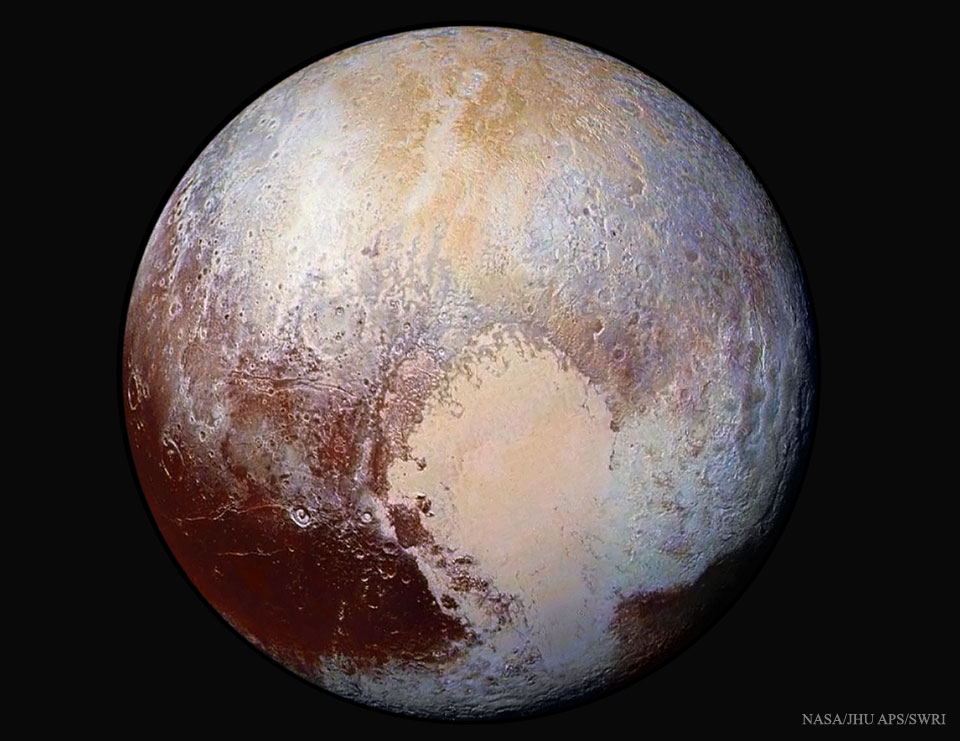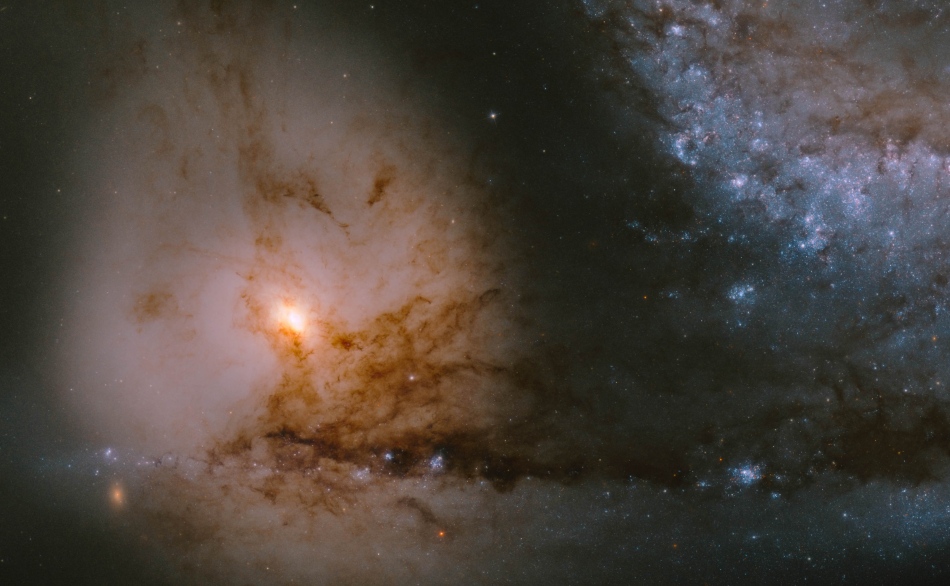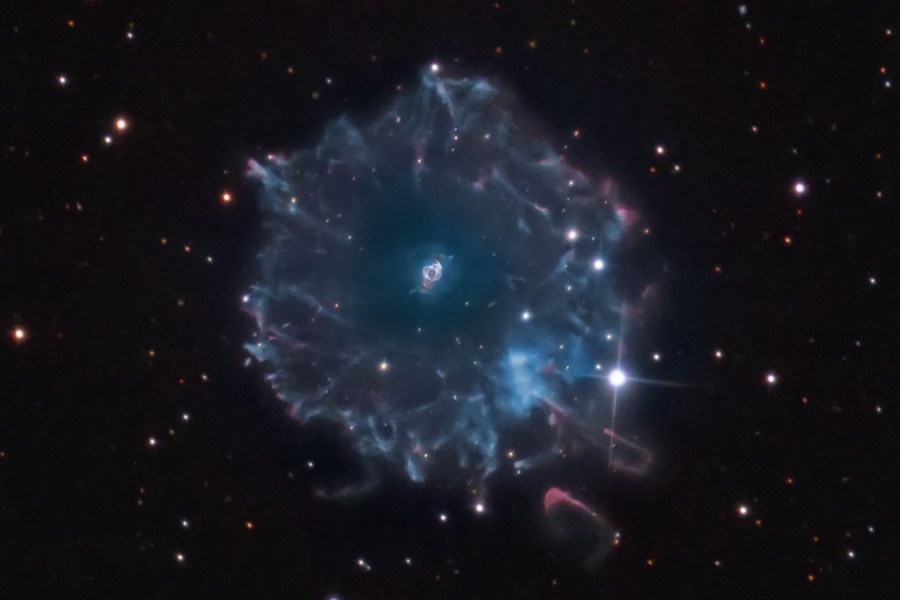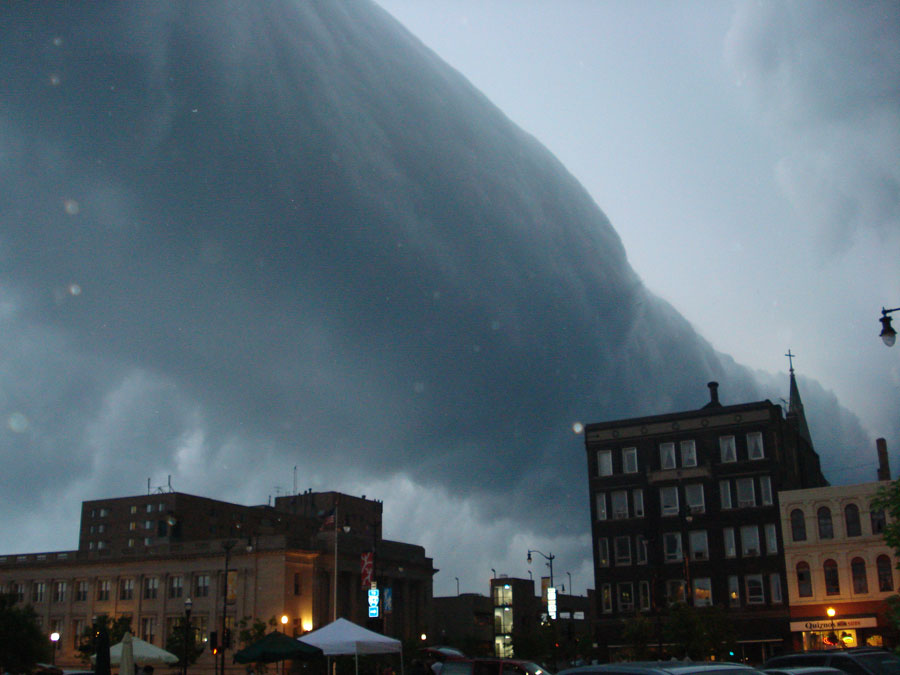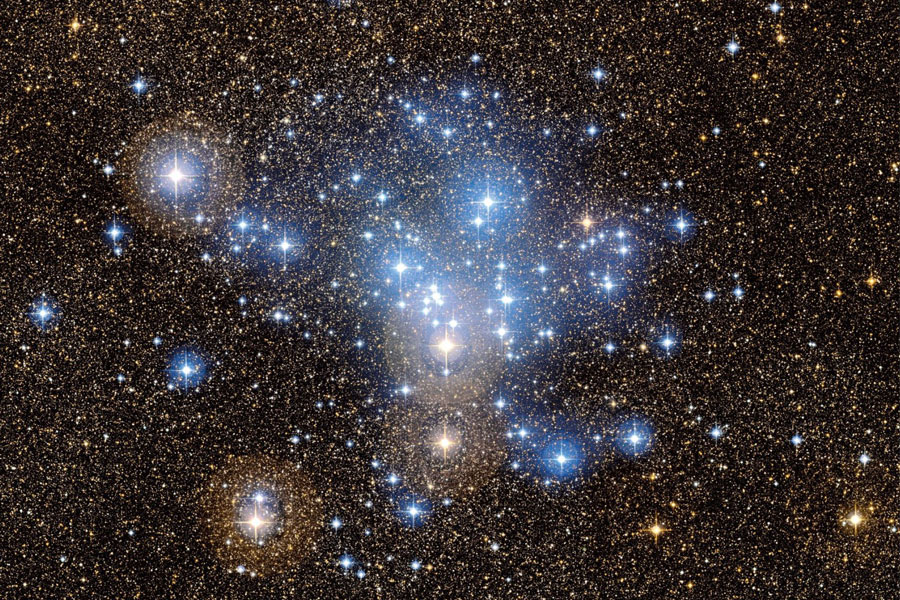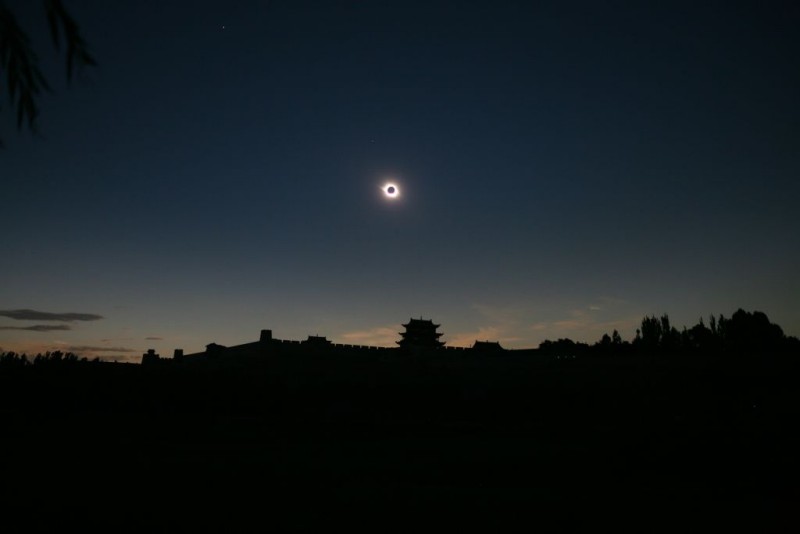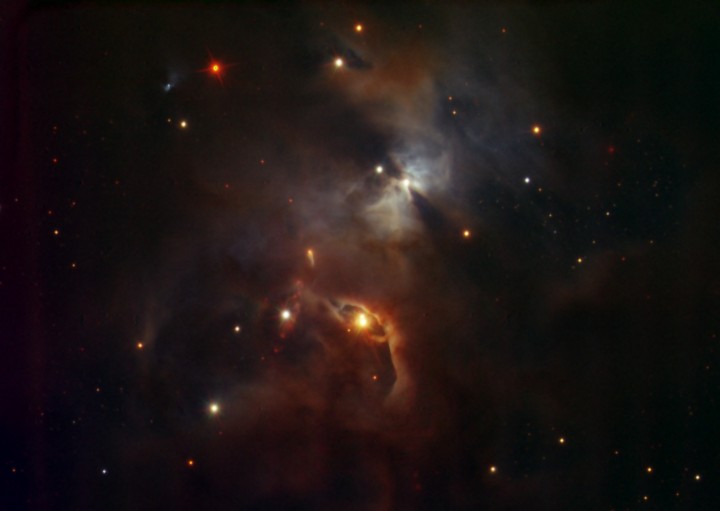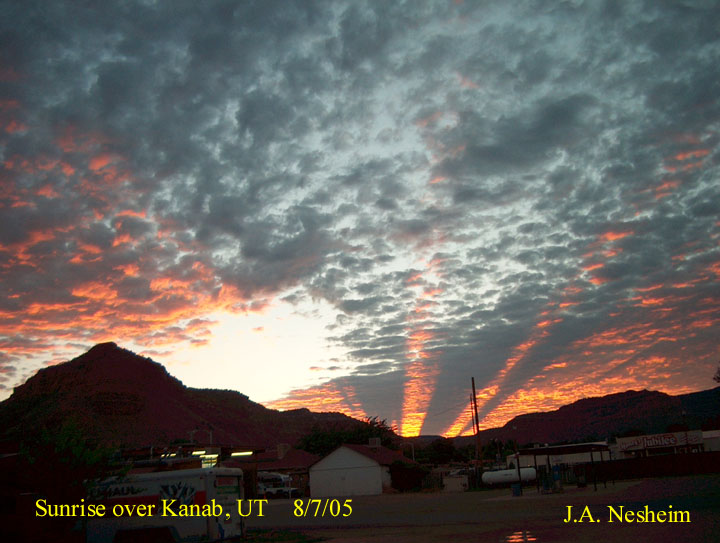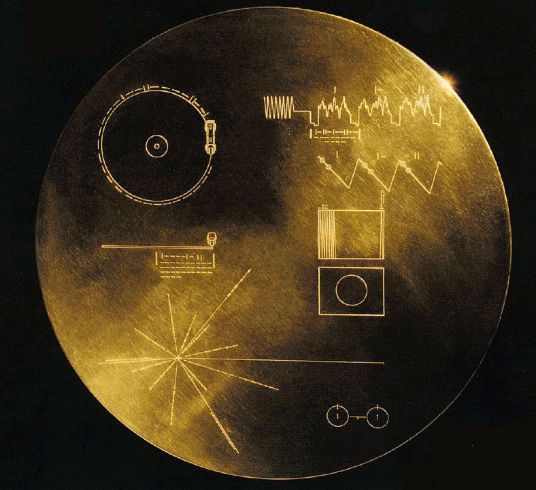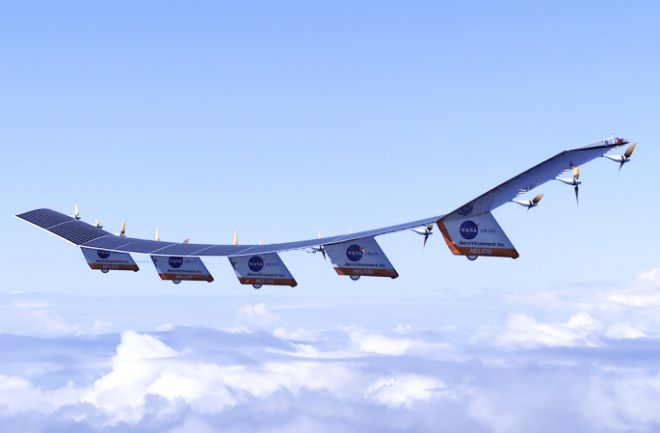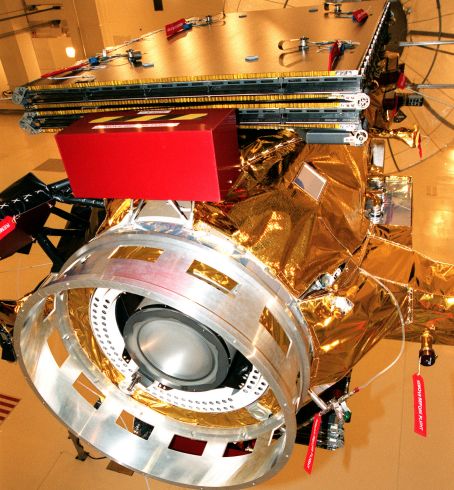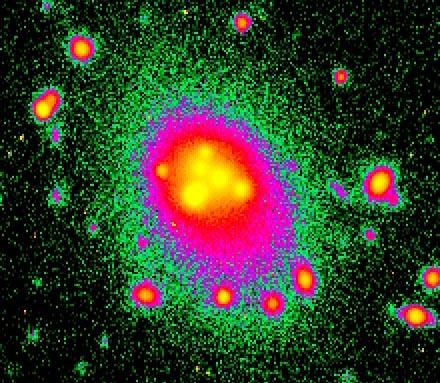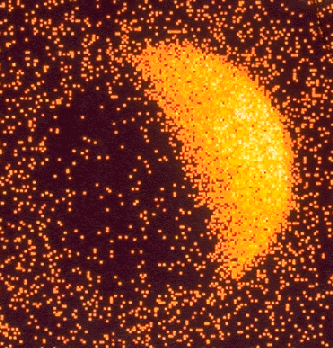| << Previous | Index | Next >> |
2015 Pluto is more colorful than we can see. Color data and images of our Solar System's most famous dwarf planet, taken by the robotic New Horizons spacecraft during its flyby in July, have been digitally combined to give an enhanced view of this ancient world sporting an unexpectedly young surface. The featured enhanced color image is not only esthetically pretty but scientifically useful, making surface regions of differing chemical composition visually distinct. For example, the light-colored heart-shaped Tombaugh Regio on the lower right is clearly shown here to be divisible into two regions that are geologically different, with the leftmost lobe Sputnik Planum also appearing unusually smooth. New Horizons now continues on beyond Pluto, will continue to beam back more images and data, and will soon be directed to change course so that it can fly past asteroid 2014 MU69 in 2019 January.
2014 How was this picture taken? Usually, pictures of the shuttle, taken from space, are snapped from the space station. Commonly, pictures of the space station are snapped from the shuttle. How, then, can there be a picture of both the shuttle and the station together, taken from space? The answer is that during the Space Shuttle Endeavour's last trip to the International Space Station in 2011 May, a supply ship departed the station with astronauts that captured a series of rare views. The supply ship was the Russian Soyuz TMA-20 which landed in Kazakhstan later that day. The above spectacular image well captures the relative sizes of the station and docked shuttle. Far below, clouds of Earth are seen above a blue sea.
2013 Dwarf galaxy NGC 5195 is best known as the smaller companion of spiral M51, the Whirlpool galaxy. Seen together they seem to trace the curve and dot of a cosmic question mark, recorded in Lord Rosse's 19th century drawings as one of the original spiral nebulae. Dwarfed by enormous M51 (aka NGC 5194), NGC 5195 spans about 20,000 light-years. A close encounter with M51 has likely triggered star formation and enhanced that galaxy's prominent spiral arms. Processed from image data available in the Hubble Legacy Archive, this majestic close-up of NGC 5195 makes it clear that the dwarf galaxy now lies behind M51. A tidal bridge of dark dust clouds and young blue star clusters stretches from the outskirts of M51 on the right, appearing in silhouette against the dwarf galaxy's yellowish glow. The famous pair of interacting galaxies lie some 30 million light-years away, toward the handle of the Big Dipper, and the constellation of the Hunting Dogs.
2012 The Cat's Eye Nebula (NGC 6543) is one of the best known planetary nebulae in the sky. Its haunting symmetries are seen in the very central region of this tantalizing image, processed to reveal the enormous but extremely faint halo of gaseous material, about 6 light-years across, which surrounds the brighter, familiar planetary nebula. Made with narrow and broadband data the composite picture shows the remarkably strong extended emission from twice ionized oxygen atoms in blue-green hues and ionized hydrogen and nitrogen in red. Planetary nebulae have long been appreciated as a final phase in the life of a sun-like star. But recently many planetaries have been found to have halos like this one, likely formed of material shrugged off during earlier active episodes in the star's evolution. While the planetary nebula phase is thought to last for around 10,000 years, astronomers estimate the age of the outer filamentary portions of this halo to be 50,000 to 90,000 years.
2011 What kind of cloud is this? A type of arcus cloud called a roll cloud. These rare long clouds may form near advancing cold fronts. In particular, a downdraft from an advancing storm front can cause moist warm air to rise, cool below its dew point, and so form a cloud. When this happens uniformly along an extended front, a roll cloud may form. Roll clouds may actually have air circulating along the long horizontal axis of the cloud. A roll cloud is not thought to be able to morph into a tornado. Unlike a similar shelf cloud, a roll cloud is completely detached from their parent cumulonimbus cloud. Pictured above, a roll cloud extends far into the distance as a storm approached in 2007 in Racine, Wisconsin, USA.
2010
[imghover6=http://apod.nasa.gov/apod/image/1008/gc ... nandez.jpg]http://apod.nasa.gov/apod/image/1008/gc ... otated.jpg[/imghover6]Credit & Copyright: Jaime Fernandez
2009
2008 Contrary to the famous myth, you can't see the Great Wall of China from the Moon ... even during a total solar eclipse. But on August 1 you could see the Moon eclipsing the Sun from the Great Wall. In fact, from this location near the Great Wall's western end, the Moon completely blocked the Sun's overwhelming disk revealing a shimmering solar corona and bright planets in the briefly darkened sky. A main pass, The Great Wall's Jiayuguan Fort, is also silhouetted in the foreground. The pass is the western-most of the wall's passes and the best preserved, initially built around 1372 during the Ming dynasty. The nearby city of Jiayuguan in Gansu Province was an important stop on the Silk Road.
2007 Stars are forming in a dense molecular cloud a mere 1,000 light-years away in the constellation Serpens Cauda (The Serpent's Tail). At that estimated distance, this sharp, near-infrared close-up of the active Serpens star-forming region spans about 2 arcminutes or just over half a light-year. Though such near-infrared observations can be made by mountain-top telescopes with specialized detectors, near-infrared light has too long a wavelength to be visible to the eye. This view was recorded with a sensitive camera, HAWK-I (High Acuity, Wide field K-band Imaging), just commissioned at the Paranal Observatory in Chile. Intended to illustrate HAWK-I's impressive capabilities, the tantalizing image highlights reddish young stars and protostars, likely up to a few million years old, emerging from the nebular gas and dust.
2006 Careful inspection of the full field of view for this sharp composite image reveals a surprising number of galaxies both near and far toward the constellation Ursa Major. The most striking is clearly NGC 3718, a warped spiral galaxy found near picture center. NGC 3718's faint spiral arms look twisted and extended, its bright central region crossed by obscuring dust lanes. A mere 150 thousand light-years to the right is another large spiral galaxy, NGC 3729. The two are likely interacting gravitationally, accounting for the peculiar appearance of NGC 3718. While this galaxy pair lies about 52 million light-years away, the remarkable Hickson Group 56 can also be seen clustered just below NGC 3718. Hickson Group 56 consists of five interacting galaxies and lies over 400 million light-years away.
2005 What could cause such rays of dark? Dark sky rays were caught in spectacular fashion earlier this month above Utah, USA. The cause is something surprisingly familiar: shadows. Clouds near the horizon can block sunlight from reflecting off air, making columns outward from the Sun appear unusually dark. Cloud shadows can be thought of as the complement of the more commonly highlighted crepuscular rays, also visible above, where sunlight pours though cloud holes. Sometimes, on the opposite side of the sky, anticrepuscular rays can also be seen.
2004 What causes the black dots on dunes on Mars? As spring dawns on the Northern Hemisphere of Mars, dunes of sand near the poles begin to defrost. Thinner regions of ice typically thaw first revealing sand whose darkness soaks in sunlight and accelerates the thaw. By summer, the spots will have expanded to encompass the entire dunes that will then be completely thawed and dark. The carbon dioxide and water ice actually sublime in the thin atmosphere directly to gas. Taken in mid-July, the above image shows a field of spotted polar dunes spanning about 3 kilometers near the Martian North Pole. Meanwhile, in the Southern Hemisphere of Mars, the Earth-sent robot Martian rovers will try to survive through Martian winter, which peaks in mid-September.
2003 What would it be like to stand atop the tallest mountain on Earth? To see a full panoramic vista from there, scroll right. Visible are snow peaked mountains near and far, tremendous cliffs, distant plateaus, the tops of clouds, and a dark blue sky. Mt. Everest stands 8.85 kilometers above sea level, roughly the maximum height reached by international airplane flights, but much less than the 300 kilometers achieved by a space shuttle. Hundreds of people have tried and failed to climb the behemoth by foot, a feat first accomplished successfully in 1953. About 1000 people have now made it to the summit. Roddy Mackenzie, who climbed the mountain in 1989, captured the above image. Mt. Everest lies in the Himalayan mountains in the country of Nepal. In the native language of Nepal, the mountain's name is "Sagarmatha" which means "forehead of the sky."
2002 Launched twenty-five years ago, NASA's Voyager 1 and 2 spacecraft are now over 10 billion kilometers from the Sun. Still operational, the Voyagers are being tracked and commanded through the Deep Space Network. Having traveled beyond the outer planets, these remarkable spacecraft are only the third and fourth human built artifacts to escape our solar system, following in the footsteps of Pioneer 10 and 11. A 12-inch gold plated copper disk containing recorded sounds and images representing human cultures and life on Earth, is affixed to each Voyager - a message in a bottle cast into the cosmic sea. The recorded material was selected by a committee chaired by the late Carl Sagan. Simple diagrams on the cover (visible above) represent symbolically the spacecraft's origin and give instructions for playing the disk. The exotic construction of the disks should provide them with a long lifetime as they coast through interstellar space. The two spacecraft will not make a close approach to another planetary system for at least 40,000 years.
2001 Solar-powered, remotely piloted, and flying at about 25 miles per hour, NASA's Helios aircraft, is pictured above at 10,000 feet in skies northwest of Kauai, Hawaii on August 13. This ultralight propeller driven aircraft, essentially a flying wing with 14 electric engines, was built by AeroVironment Inc. Covered with solar cells, Helios' impressive 247 foot wide wing exceeds the wing span and even overall length of a Boeing 747 jet airliner. Climbing during daylight hours, the prototype aircraft ultimately reached an altitude just short of 100,000 feet, breaking records for non-rocket powered flight. Helios is intended as a technology demonstrator, but regular, long-duration flights at that altitude could be used for environmental monitoring missions and, communications relays. In the extremely thin air 100,000 feet above Earth's surface, the flight of Helios also simulates conditions for winged flight in the atmosphere of Mars.
2000 At full throttle the Deep Space 1 spacecraft's innovative ion drive produces about 1/50th of a pound of thrust ... a force so great that it would just about hold up a piece of paper on planet Earth! Still, powered by solar arrays ion propulsion systems can run continuously. For long duration space missions they ultimately win out over the powerful but brief blasts of less efficient chemical rockets. Deep Space 1 is seen here suspended in an assembly room, a folded solar array resting above the circular ion propulsion module. Already a successful technology demonstrator with experimental autonomous software, the spacecraft flew by asteroid 9969 Braille in July of 1999 but later that year, in November, the robot probe was nearly lost due to the failure of its wide-field star tracker camera. Now, the adventures of Deep Space 1 can continue. Engineers were able to reprogram the navigation system to utilize another on-board camera and on 28 June 2000 the ion drive was throttled up. Once again steering by the stars, Deep Space 1 is presently bound for a September 2001 rendezvous with periodic Comet Borrelly.
1999 The two stars at the center of this nebula are very different. One is a white dwarf star with a mass similar to our Sun but with a radius as small as our Earth. The other star is a red giant, a star also with mass near our Sun but with a radius so large it could fill the orbit of the Earth. The strange symbiotic relationship between these two stars in the He2-104 system has created a planetary nebula shaped like an hourglass within an hourglass. The red giant star turns out to be a Mira variable, a pulsating star that is dumping mass into an accretion disk surrounding the white dwarf. Astronomers speculate that when enough mass falls onto the white dwarf, a thermonuclear explosion occurs creating another expanding hourglass-shaped nebula. The above photograph was taken with the WFPC2 instrument onboard the Hubble Space Telescope. The hourglasses from the two most recent explosions are visible with the last one highlighted in the inset.
1998 It was mealtime in galaxy cluster Abell 3827. The hungry cluster dominant galaxy in A3827's center is seen being fed. Breakfast included five smaller galaxies unfortunate enough to wander too close to the cluster's central supergiant galaxy. The remnants of these five galaxies can be seen in the center of this false-color picture. A single massive galaxy dominates the centers of many compact clusters of galaxies. A3827 is so distant, having a redshift of 0.1, that light takes about 1.5 billion years to get here from there. We are therefore seeing this cluster only as it existed 1.5 billion years ago, so that these five galaxies are probably by now all digested into the huge cluster center.
1997 Is this one galaxy or two? Analysis of Arp 230 has shown evidence that this seemingly single spiral galaxy is actually the result of the recent collision of two spiral galaxies. The slow motion collision took place over about 100 million years and induced a burst of star formation that has begun to subside. The collision apparently had many similarities to the colliding galaxy sequence in the IMAX movie "Cosmic Voyage."
1996 Johannes Kepler used simple mathematics to describe how planets move. Kepler was an assistant to the most accurate astronomical observer of the time, Tycho Brahe. Kepler was able to use Brahe's data to show that planets move in ellipses around the Sun (Kepler's First Law), that planets move proportionally faster in their orbits when they are nearer the Sun (Kepler's Second Law), and that more distant planets take proportionally longer to orbit the Sun (Kepler's Third Law). Kepler lived from 1571 to 1630, during the time of discovery of the telescope. Kepler was one of the few vocal supporters of Galileo's discoveries and the Copernican system of planets orbiting the Sun instead of the Earth.
1995 Above is a picture of the Moon taken in X-rays by the Roentgen Observatory Satellite ROSAT in 1990. This famous picture shows three distinct regions: a bright X-ray sky, a bright part of the Moon, and a relatively dark part of the Moon. The bright X-ray region is exemplary of the mysterious X-ray background that is seen everywhere on the sky. The bright lunar crescent shines because it reflects X-rays emitted by the Sun. The dark lunar face is surprising because it is not completely dark, and its slight emission is thought to result from energetic particles from the solar wind striking the Moon.
| << Previous | Index | Next >> |
